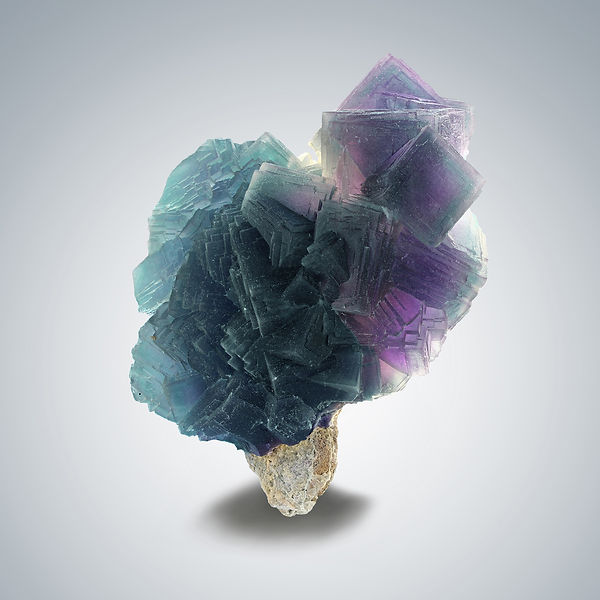

2021, July, Fluorite, Summit Cleft, Weisseck
Twenty years have passed since the discovery at 2,700 meters height of the Summit Cleft. Collectors have extracted many beautiful fluorites that have been described, along with this extraordinary site, in numerous detailed accounts. Agreement is widespread that the time of the great finds is long gone. It has become quiet around the Summit Cleft. Yet, one tantalizing feature remains: a crystallized cavity that through all these years of active collecting was still largely untouched. This holdout consists of a narrow, crystallized tubular area that leads into a larger crystallized cavity, which then narrows. Collectors have certainly looked longingly into this cavity. A few old chisel marks testify to earlier attempts to break into the cavity. But the limestone there is simply too hard. So other than a few pathetic shots at breaking through, this particular cavity remained untouched. Thirteen years ago, I stretched my arm into the larger cavity and managed to take some photos. These revealed very nice fluorite in areas that otherwise couldn't be seen from the outside. It was hard to forget what these photos revealed and promised. Finally, these haunting images eventually drove me to seek relief: five years ago I once again climbed to Weisseck’s summit and desperately tried to open the cavity through intensive prying. I failed miserably. And then again, two years later, a second effort also ended dismally. Still, on my first attempt, I managed to find two beautiful hand pieces in the front area. For a long time these two pieces lay in a box, only roughly cleaned, and forgotten. Finally, I found time last year to give these specimens a careful cleaning and formatting. They proved to be too beautiful: the two pieces thoroughly enchanted me so that I had no choice but to try once again. I had the winter to consider strategy. Nothing seemed certain as others and myself had repeatedly tried and failed. Still, I convinced myself that even if opening this cavity required repeated great exertions over time, it would still be worth the effort as the specimens there possessed a special charm.

This photo, taken 13 years ago, inspired me to work here
So the matter was decided. I started my project in June. Among other challenges the weather had to be stable. This is necessary because working intensely in the Summit Cleft means you don't notice changes in the weather, which at 2.700 meters up, can suddenly turn nasty. I left home very early in the morning and reached the Summit Cleft still early in the day.
.jpg)
A wonderful morning with sheep on the Riedingscharte
It took a while until I reached the point in the Summit Cleft. Highly motivated, I started my frantic chiseling. It did not take long before I realized that my well thought-out strategy did not quite match the realities at the site. Desperation! I was brutally reminded about the limestone’s hardness and resilience. It was not for nothing that I had already tried twice in vain. But I refused to give up. I summoned my perseverance, or rather: I simply bit down at this point and would not let go. Whenever my strength ran out or despair arose, I thought of those two pieces at home and somehow I managed to keep working. Several days later and after much sweat, cursing, and exertions, I reached the fluorites. I did it! And now some very beautiful fluorites are in my showcase; a most satisfying reward.
These are the two pieces salvaged from the cleft in 2016 that motivated me to endure so much strenuous work:
.jpg)
Large fluorite cube with parquet construction and intensive color zoning, collection: Robert Marc Friedman, 6.7 x 6.3 x 5.5 cm
.jpg)
Single fluorite cube with intensive color zones, embedded in calcite, 6.5 x 6.5 x 3.5 cm
And these are the first beauties that I finally extracted after days of laboring:
.jpg)
The first beautiful piece fresh from the cleft
.jpg)
A particularly beautiful piece - the effort was worth it for that alone!
.jpg)
The same piece photographed outdoors
.jpg)
And another showcase piece!
The fluorites found in this cavity are either crystallized as sharp-edged cubes, or they are fused together with multiple stepped edges. Due to the protected location in the fissure cavity, the crystallizations were largely spared from atmospheric degradation. This resulted in the consistently high surface quality of the fluorites, which have edge lengths of up to 5 cm. The fluorites show slightly concave cube surfaces with a square texture on the surface. In the outer area of most fluorites there is a pronounced zonal coloration that goes into cyan, whereby the core usually shines in a beautiful violet-purple in transmitted light. This particular color combination is differently pronounced in the pieces. The stepped pieces have a rather inconspicuous blue-green color. When looking at these pieces from the side, however, they reveal a wonderful new quality: An intense color zone that differs significantly from the usual fluorites from the Summit Cleft: the colors cyan and blue appear very intense here. The more common light green and light yellow tones are subordinate.
.jpg)
This piece shows a particularly intense color zoning, 10 x 7 x 5 cm
.jpg)
Perhaps the most beautiful piece from this find, 13.7 x 10 x 6.5 cm
.jpg)
Two fluorite cubes grown together showing intense color and zoning, 5.7 x 4.5 x 4 cm
.jpg)
Another piece with intensive color zoning, 10.8 x 8 x 4.8 cm
.jpg)
Light fluorite with zoning in combination with calcite, 8.5 x 6 x 2.9 cm
.jpg)